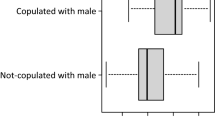Abstract
This study tested the physiological and behavioural effects of a resource asymmetry between guinea pig males. Asymmetry was defined via cohabitation with a female in a home area during a 5-day period. An experimental setup was designed in which the same male alternated between being in this home area (and monopolizing a female therein) and playing the role of an intruder. The confrontation phase between the resource holder and the intruder lasted 5 days. Behavioural data were collected for 0.5 h at the start of the confrontation and again for 0.5 h at 3, 24, 72, and 120 h after the onset of confrontation. Blood samples were taken before the test started and after 3, 72, and 120 h. Body mass was registered before and after the confrontation phase. The results indicate that resource holders were more highly motivated than intruders in displaying aggressiveness. They exhibited more chasing behaviour and won more confrontations. Both male groups performed almost identical frequencies of threat displays and courtship behaviour. Physiologically, the resource holders lost less body mass and showed increased plasma testosterone concentrations after 120 h. Resource holders also exhibited steady plasma corticosteroid concentrations, whereas the intruders showed elevated corticosteroid levels at 72 and 120 h. The results show that when acting as a resource holder, males react according to the resident-always-wins hypothesis, and when acting as an intruder, lose most confrontations. We conclude that the behavioural and physiological reaction of males during confrontations is determined to a greater extent by environmental asymmetries than by experiences or physical conditions before the conflict.


Similar content being viewed by others
References
Altmann J (1974) Observational study of behaviour: sampling methods. Behaviour 49:227–267
Arnold W, Dittami J (1997) Reproductive suppression in male alpine marmots. Anim Behav 53:53–66
Austad SN (1983) A game theoretical interpretation of male combating the bowl and dolly Spider (Frontinella pyramitela). Anim Behav 31:59–73
Barkley MS, Goldman BD (1977) Testosterone-induced aggression in adult female mice. Horm Behav 9:76–84
Brain PF (1980) Adaptive aspects of hormonal correlates of attack and defence in laboratory mice: a study in ethobiology. Rec Prog Br Res 53:391–413
Davies NB (1978) Territorial defense in the speckled wood butterfly (Pararge aegeria): resident always wins. Anim Behav 26:138–147
Dewsbury DA (1984) Aggression, copulation and differential reproduction of deer mice (Permyscus maniculatus) in a semi-free enclosure. Behaviour 91:1–23
Dudzinski ML, Mykytowycz R, Gambale L (1977) Behavioral characteristics of adolescence in young and captive European rabbits, Oryctolagus cuniculus. Aggress Behav 3:313–330
Flannelly KJ, Lore R (1977) The influence of females upon aggression in domesticated male rats (Rattus norvegicus). Anim Behav 20:785–790
Haemisch A (1988) Experimentelle Untersuchung zum Einfluß Sozialer Aufzuchtbedingungen auf Dominanz-Qualität, Verhalten und Endokrine Reaktionsmuster Männlicher Hausmeerschweinchen (Cavia aperea f. porcellus). Unpublished dissertation, University of Bielefeld
Hopp M, Rasa OAE (1990) Territoriality and threat perceptions in urban humans. In: Dennen J van der, Falger V (eds) Sociobiology and conflict—evolutionary perspectives on competition, cooperation, violence and warfare. Chapman and Hall, London, pp 131–149
Huntingford FA, Turner A (1987) Animal conflict. Chapman and Hall, London
Krebs JR, Davies NB (1993) Fighting and assessment. In: Krebs JR, Davies NB (eds) An introduction to behavioural ecology. Blackwell, London, pp 147–173
Kunkel P, Kunkel I (1964) Beiträge zur Ethologie des Hausmeerschweinchen. Z Tierpsychol 21:602–641
Martin P, Bateson P (1993) Measuring behaviour. Cambridge University Press, Cambridge
Maynard Smith J, Reichert SE (1984) A conflicting tendency model of spider agonistic behavior: hybrid–pure population line comparisons. Anim Behav 32:564–578
Mazur A, Booth A (1998) Testosterone and dominance in men. Behav Brain Sci 21:353–397
Mazur A, Booth A, Dabbs J (1992) Testosterone and chess competition. Soc Psychol Q 55:70–77
Monaghan EP, Glickman SE (1992) Hormones and aggressive behavior. In: Becker JB, Breedlove SM, Crews D (eds) Behavioral endocrinology. MIT Press, Cambridge, Mass., pp 261–285
Parker GA (1974) Assessment strategy and the evolution of fighting behaviour. J Theor Biol 47:223–243
Raab A, Dantzer R, Michaud B, Mormede P, Taghouti K, Simon H, Lemoul M (1986) Behavioral, physiological and immunological consequences of social status and aggression in chronically coexisting resident–intruder dyads of male rats. Physiol Behav 36:223–228
Rhine RJ, Linville AK (1980) Properties of one-zero scores in observational studies of primate behaviour: the effect of assumptions on empirical analyses. Primates 21:111–122
Rood JP (1972) Ecological and behavioral comparisons of three genera of Argentine cavies. Anim Behav Monogr 5:1–83
Sachser N (1986) The effects of long-term isolation on physiology and behavior in male guinea pigs. Physiol Behav 38:31–39
Sachser N (1993) The ability to arrange with conspecifics depends on social experiences around puberty. Physiol Behav 53:539–544
Sachser N, Lick C (1989) Social stress in guinea pigs. Physiol Behav 46:137–144
Sachser N, Pröve E (1984) Short-term effects of residence on the testosterone responses to fighting in alpha male guinea pigs. Aggress Behav 10:285–292
Sachser N, Dürschlag M, Hirzel D (1998) Social relationships and the management of stress. Psychoneuroendocrinology 23:891–904
Schuurman T (1980) Hormonal correlates of agonistic behaviour in adult male rats. Prog Brain Res 53:415–420
Scott JP, Fredericson E (1951) The causes of fighting in mice and rats. Physiol Zool 24:273–309
Tinbergen N (1957) Social behavior in animals. Methuen, London
Wickler W, Seibt U (1991) Das Prinzip Eigennutz—Zur Evolution Sozialen Verhaltens. Piper, Munich
Wingfield JC, Hegner RE, Dufty AM Jr, Ball GF (1990) The "challenge hypothesis": theoretical implications of patterns of testosterone secretion, mating systems and breeding strategies. Am Nat 136:829–846
Author information
Authors and Affiliations
Corresponding author
Additional information
Communicated by R.F. Oliveira
Rights and permissions
About this article
Cite this article
Wallner, B., Dittami, J. Behavioural and physiological consequences of home advantage resource holding in male guinea pigs. acta ethol 5, 101–105 (2003). https://doi.org/10.1007/s10211-003-0076-7
Received:
Revised:
Accepted:
Published:
Issue Date:
DOI: https://doi.org/10.1007/s10211-003-0076-7




